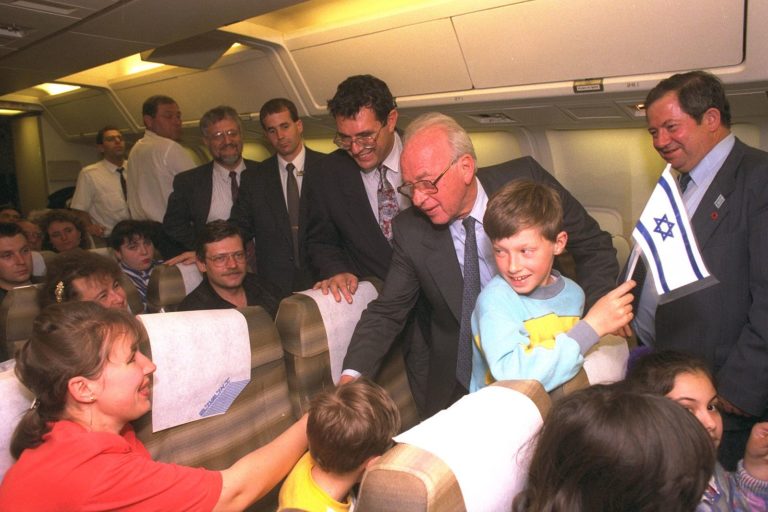
Beginning in 1990, following the initial collapse of the Soviet Union, more than one million Russians immigrated to Israel within 10 years. To put this in perspective, Israel’s population at the start of this wave (in 1990) was about 5 million people, so this was an enormous aliyah. Why did this happen and how did it change Israeli society?
How the Russian aliyah happened
The exodus began with Natan Sharansky’s arrival in Israel in 1986. Sharansky was born in Ukraine (then part of the Soviet Union). The Jewish community there was facing oppression under the Soviet regime.
The Jewish community’s “religious life was squashed by the [Soviet] authorities,” Israeli author Matti Friedman explained on the Tikvah podcast.
“They were not allowed to express their Judaism. They were not allowed to express Zionism, which was virulently opposed by the Soviet regime and condemned as a form of racism, and they were not allowed to leave for Israel,” Friedman said.
But Soviet Jews faced immense difficulty in emigrating from Russia to countries that respected their basic human rights. Even just applying to leave the country had seriously harsh consequences.
If they applied, Russian Jews almost surely lost their jobs, were blacklisted, and even faced imprisonment, which meant that hundreds of thousands of Jews were stuck in Russia against their will.
These Jews came to be known as the “refuseniks,” and their plight became the focal point of the free Soviet Jewry Movement. Sharansky became the icon of the refusenik campaign and the one person who came to personify Soviet Jewry’s struggle. Watch our video to learn more about the refuseniks and the movement to free Soviet Jewry.
In 1973, Sharansky applied for an exit visa to Israel, but was denied. Following this denial, Sharansky became an activist and advocate for Soviet Jewish emigration, which in 1978 resulted in his arrest by the Soviets for trumped up charges of treason and spying for the US.
Sharansky was sentenced to 13 years in a forced labor camp in Siberia. This galvanized the American Jewish community to push for the freedom of Soviet Jewry. Sharansky was freed in 1986 and moved to Israel where he was welcomed as a hero.
While Sharansky was free, three million Jews were still left behind the Iron Curtain facing oppression. In 1989, as the Soviet Union began to collapse, Soviet leader Mikhail Gorbachev approved measures that allowed Jews to leave the country. In the next decade, more than one million Russians immigrated to Israel.
Israel: Mosaic or Melting Pot?
When the Iron Curtain fell in 1989, then-Minister of Finance Shimon Peres (who would later become Prime Minister) did not think hundreds of thousands would emigrate, saying, “We’ll get 10 to 15 thousand, but why should they leave?”
And his counterpart on the right, then-Prime Minister Yitzhak Shamir, was also skeptical that Russian Jewry would immigrate to Israel, stating: “They report that most Jews in Moscow are studying English, not Hebrew. They want to go to America.” Both, however, insisted that Israel would be able to mobilize as a country to absorb a potential mass migration.
Israel had done this before. In the late 1940s, Israel absorbed thousands of Holocaust survivors, and then brought in another 850,000 immigrants who had been expelled from North African and Middle Eastern countries.
But there was a big distinction. These Jews from across the globe were asked to fit into former Israeli Prime Minister David Ben Gurion’s vision of an Israeli “melting pot,” in which Jews from across the world would blend into one distinct “new Jew,” the Israeli Jews.
They would get rid of much of their culture, some of their religious elements and become part of the burgeoning Israeli culture. Natan Sharansky and Gil Troy, in their book “Never Alone,” explain that the Russian immigrants had a very different perspective. They were “fleeing the Soviet system, not Russian culture,” they wrote.
These immigrants wanted Israel to become a mosaic of different cultures, ideas, and languages, one in which they could express their Russian identity. It would be a “Jewish patchwork, dazzling everyone with its worldly diversity.”
For people like Sharanky, “identity is not a one-dimensional either-or. It’s not a battery you can replace. It’s more like fuel: when you add more into your tank, the new mixes with what was there before.”
Startup Nation
In almost no time at all, these Russian olim, or immigrants, made significant contributions to the country in the fields of science, technology, medicine and education. Many assimilated seamlessly into the labor market.
“Since the aliya from Germany in the 1930s, Israel had not encountered a group of immigrants who were so well educated and represented such impressive human capital as the aliya from Russia,” historian Anita Shapira explained, adding that the arrival of the Russian immigrants doubled the number of engineers and doctors in Israel.
These immigrants’ technological and scientific knowledge also helped Israel become the “startup nation” that we know it to be today.
“Without the aliyah from Russia, it is impossible to comprehend Israel’s conversion to a high-tech power within just a few years, with companies traded on Wall Street and extraordinary economic successes on a global scale,” Shapira wrote.
The challenges of integration
The Russian aliyah also raised questions of religion and state in Israel. Many of the new immigrants qualified for citizenship under Israel’s Law of Return (i.e., they had at least one Jewish grandparent), but were not Jewish according to halakha (religious law).
These issues continue to play out today in the Russian-speaking Israeli community. For instance, last August, Russian-speaking Israeli gymnast Artem Dolgopyat won Israel’s second-ever gold medal at the Olympics. His win prompted a debate over how Israel’s Olympic champion could not get married in the country because he is not Jewish according to halakha, and renewed calls to change Israel’s marriage laws.
The Russian immigrants also brought major changes to Israeli culture. Previous groups of immigrants had been expected to forget the culture they came from and become “Israeli,” by speaking only in Hebrew and Hebraicizing their names, for example. “The Russians were really the first to say ‘no’ and say, ‘we don’t want to jettison our culture,’” author Matti Friedman said.
Similarly, Shapira wrote that the Russian aliyah marked the end of Israel’s “melting pot” policy, and the beginning of “a pluralistic society that looked with tolerance on the immigrants’ cultural otherness and even granted it legitimacy.”
The Russian immigrants preserved their language and culture as they settled into life in Israel. They set up their own education system which taught in Hebrew but included lessons in Russian studies. They also established Russian-language newspapers, magazines and books, theaters and classical music ensembles.
The community’s internal cohesiveness also created tensions in Israel. According to Shapira, there were “popular complaints that the Russians spoke only Russian among themselves and excluded Hebrew speakers from their conversation.”
Israel may have become more pluralistic, but it had also “become resigned to a divided society with no basic consensus about values and culture,” Shapira wrote.
Originally Published Jan 25, 2022 12:02AM EST
